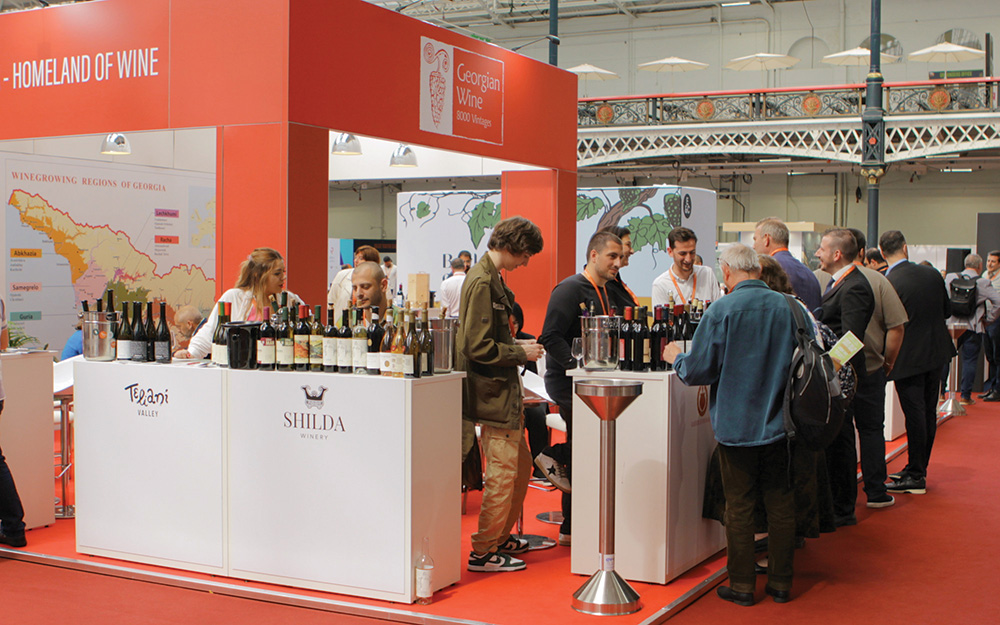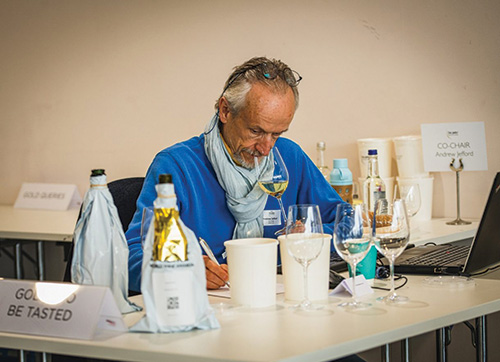How will Georgian wine fare in 2022’s flooded markets?

Prizes and medals, be there many of them, are no guarantee of business.
Record numbers of awards are being showered on Georgian wine companies, but as war rages in Ukraine and the global economy contracts, they are having a nerve-wracking time. So are the thousands of Georgian farmers whose income depends on selling grapes to them. Russia is the major market for Georgian wine and while some export trade is continuing, the next big question is how payment will be made when banking links are frozen.
Elsewhere, in China, the main target for export diversification, sales fell by 22% in Q1 as the country’s lockdown to enforce a “zero covid” policy imposed severe restrictions on consumer spending. The story for Europe is also a troubled one – imports forecasted by the European Commission in its “EU Agricultural Outlook” for 2021-2031 are set to dip, depressed by rising prices and taxes and the squeeze on consumer spending from rising interest rates and inflation. U.S. forecasts, such as those from Silicon Valley Bank in its “State of the Wine Industry 2022”, also anticipate a decline in consumption, knocking imports.

Georgia’s wine companies are thus trying like never before to sell their products in the new markets where they are winning prizes – two of those notably being the 2022 London International Wine Fair and the Raw Wine Fair (for small natural wine companies) in June. Export marketing campaigns aimed at the wealthy, mature, and knowledgeable wine drinkers of the U.S. and UK should see a boost after success in two top wine competitions. The UK’s Decanter Wine Award (the world’s largest) and the International Wine Competition (IWC) both awarded six gold medals to Georgia, the largest ever numbers. At the 2022 International Raw Wine shows for amber wines around the world, too, Georgia has been the center of attention.
UK winners included a winery owned by Lopota Lake Resort (Chateau Buera), whose Saperavi Reserve won a gold from the judges at Decanter (publishers of leading international wine magazine that goes by the same name). A little Racha winery, Itsis Marini, which produces only 40,000 bottles a year, beat the competition from many big companies to win a gold for its Bimbili Mujuretuli Reserve; and a medium-sized firm, Gvaramadze Winery, won for its Tsarapi Rkatsiteli. Among the major groups, Teliani Valley won a gold at Decanter for its Khikhvi Qvevri. Tbilvino won three gold medals in all – one at the Decanter competition for its Qvevris Kisi, another at the International Wine Challenge (IWC) for its Kisi Special Reserve, and finally, for its Qvevris Mtsvane at the London International Wine & Spirit Competition (IWSC). Other IWC gold winners were Corporation Kindzmarauli’s Khikhvi and Rkatsiteli and Alexandrov Wine Collections’ Tsinandali.
Companies at the pole ends of the spectrum were among the Georgian companies represented on the Georgian stand at the London International Wine Fair, ranging from giant group, Bolero, to other majors such as Askaneli Brothers, Dugladze, Kakheti Traditional Winemaking, Telavi Wine Cellars, Teliani Valley, Tbilvino, and Winery Khareba; medium sized groups included Kakhuri, Tsereteli, Twins Cellar, and Winery Gurjaani.
However, as they found, Georgia is still an unfamiliar foreign location. When it comes to increasing sales in Western markets, Georgia does not have the advantage of other Eastern European wine producers of being a major western tourist destination – such as Croatia or Romania. Western wine drinkers often discover new wines when on holiday, but last year, fewer than 50,000 international visitors to Georgia from Europe were recorded, which far outnumbered those from (non-drinking) Islamic countries. By contrast, Croatia attracted nearly 14 million (mostly European and U.S.) tourists.
Another blow for the wine companies who travelled to the European wine fairs – ProWein in Dusseldorf in May and the London International Wine Fair in June – was that attendance by trade buyers was much lower compared to pre-Covid times. ProWein alone announced a 38% reduction in attendance. This is explained by Nick MacSwiney of UK wine importer and exporter, Ehmanns Wines, as reflecting an “increasing view in the European wine trade that local, targeted regional wine events are gaining popularity as they are much easier on the work schedule and budget than omnibus events in foreign cities.”
However, by whatever route they are finding their way to Georgian wines, new international buyers have been drawn by the growing level of sophistication, generating forecasts (but on a business-as-usual basis) from Georgian investment house TBC Capital that 2022 would bring an 11% rise in exports to $260 million. This followed on 2021’s rise of 14%, taking export revenues to $234 million. The challenge now facing the Georgian wine industry is diversifying away from its traditional buyers in the CIS at a time when world competition is so fierce, and first-time, but top quality, producers are emerging in Japan, India, and China.
As TBC Capital’s latest publication on the Georgian wine industry states, a negative impact from the Russian war seems inevitable, and the fear is that it could cut exports by as much as 44%. “As the overall situation on the market worsens and more wine is left unsold, the financial value of this excess is $116 million,” estimates the TBC Capital research team in its forecasts.

“Despite discovering new markets, dependency on the Russian market remained significant since the cancellation of the embargo in 2013, ranging from 47% to 67%. In 2021 the share of Russia in Georgian exports was 56%, followed by Ukraine with a 10% share, China – 7%, Poland – 6%, Belarus – 5%, and Baltic countries – 4%,” states the TBC Capital report Wine Industry Back to Turmoil.
The situation is worsened, says the TBC research team, by the fact that exports are the main driver for sector revenue, contributing 79% of the total. Plus, Russia consumes the cheapest of Georgia’s wines, which will be hard to redirect to non-CIS countries.
And that is not the only problem: Georgia has 19% of the Russian market, with other exporters to Russia including Italy with 24% and Spain and France both with 15%. “Georgia will face increased competition on alternative export markets as the world supply of wine will seek to substitute the Russian market,” says TBC Capital. Adding to the difficulties for Georgian producers, the type of wines preferred by Russia and Ukraine, red semi-sweet, are not popular outside CIS markets.
At the moment wine from everywhere seems to be getting into Russia, but European exporters may decide to stop sending their products, which would bring the threat of a wine flood and sharp competition to international markets. Leaving the Russian market may be done on reputational or ethical grounds, or because of difficulties in transferring payment through a frozen banking network, as key Russian banks have lost access to the global payments system SWIFT.
The numbers in the TBC Capital forecasts range from a 38% drop in exports to Russia if there is a near-term resolution of the war, one of 90% to Ukraine, and 10% to other countries. The falls increase to 55% for Russia and 14% to other countries if the war drags on.
“The question is how will companies manage reduced demand on critical markets and unsold stock? Will they attempt to redistribute the stock on alternative markets or reserve it for a better future?” asks TBC Capital.
The Georgian government has been backing expansion of the wine producers export forays into Europe, Asia, and the U.S. with increasing budgets – and this has been paying off. But it will face a severe challenge this year deciding how to handle subsidies for the companies.
At the London Fair, many of the small wine Georgian companies seemed remarkably relaxed, perhaps because they have diversified their business models by adding a guesthouse and tourism. One such company is Anapea, a small Kvareli family winery run by a professional couple who have built a collection of 33 indigenous Kakhetian grape varieties and are planning a qvevri museum. Or Akmeta, co-owned by tobacco marketing consultant Nick Garsevanishvili, who has used his expertise on trips to U.S. natural wine fairs to win several importers. Or like Itsis Marani’s Sulkhan Turmanidze, whose investment in his Bimbili wines from his day-job earnings as a traffic-flow consultant has won him a Gold Medal in London – and hopefully, export buyers. Medium-sized Winery Gurjaani has avoided Russian markets and expanded widely, its solution being diversifying into fruit and vegetable juices and grape concentrate, reaching markets as far as Africa.
More difficult is to devise a beverage strategy for 2030 for a giant wine and spirit producer, such as Bolero, which is part of one of Georgia’s largest industrial groups and has its own Poti Port Free Zone bulk stock terminal. It has huge business in Russia, Ukraine, China, and Central Asia and has specialised in the lower price ranges. However, it is already selling in Europe and it has not yet broached the U.S. market.
Another factor will inevitably change: profits. The wine and spirit business has been one of the most profitable businesses in Georgia, as investment bankers Galt &Taggart pointed out last year in their regular industry review. “The sector posted 30.2% gross profit and 20.8% operating profit margins in 2019, 1.4x and 1.7x above business sector averages.” The numbers are bound to look a bit different in 2022.

